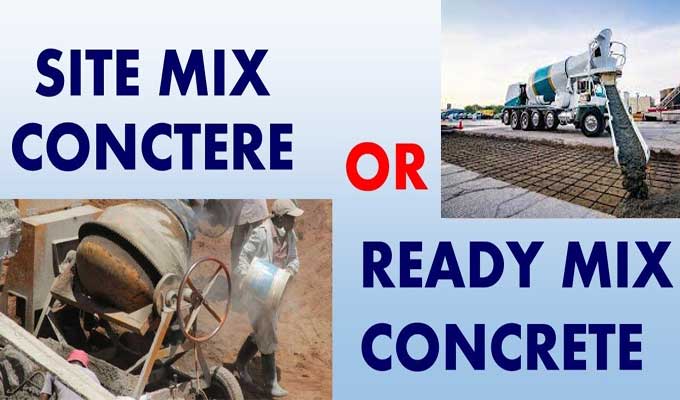
The Differences between Ready Mix Concrete and Site Mix Concrete
Water, aggregates, and Portland cement are the components of concrete mix, one of the most widely used construction materials. Ready-mixed concrete and site-mixed concrete are the two main types of concrete in the construction industry. As both types have their pros and cons, choosing the right one for your project is crucial. Depending on the project conditions, one type may be more beneficial than the other in concrete construction.
An infrastructure built on a sound concrete mix is solid and stable. A streamlined construction process creates concrete structures that are durable and strong. Developing better concrete mixing can be difficult due to the distinctive properties of each ingredient. The physical properties of each component have to evaluate first. Furthermore, the current location must assess in terms of its bearing capacity.
Key Differences between Site Mix Concrete & Ready Mix Concrete
The comparison between these two types of concrete will be based on several factors. There are also factors such as time, equipment, distribution, recommended applications, waste, storage equipment, workforce, quality, material takeoff, and other significant factors. Software for crew scheduling must consider. That will facilitate a more efficient process. That will eliminate the need for concrete contractors to track everything manually.
Site Mix Concrete
The concrete is usually prepared on-site and is volumetric, as the name implies. A concrete component will use & mix in specific proportions to achieve the strength needed.
It takes formulas to accurately calculate the steps and material requirements for a procedure like this. To avoid quality conflicts in the concrete, concrete workers need to be meticulous and cautious about the standard proportions of the materials. Using task scheduler software is very helpful in being more precise with standard proportions. Concrete experts can use the tool to oversee and manage all strategies and methods used during a project.
Advantage of Site Mix Concrete
- Concrete experts produce high-quality and economic concrete by following a well-organized supervision process.
- When it comes to concrete work scheduled with an external agency, a small quantity of batch can be required and produced.
- To save money, project managers can do value engineering to optimize the design based on strength results.
- Quantity restrictions do not apply.
- For concrete work, it is not necessary to hire external agencies.
- Ready-mix concrete costs about 20% more than site-mix concrete.
Disadvantage of Site Mix Concrete
- Stocking materials requires more space.
- Taking care of site logistics is essential.
- Regular monitoring requires the waste of used materials and periodic reconciliation.
- On-site supervision of concrete production should be provided by qualified personnel.
Ready Mix Concrete
Ready-mix concrete is usually manufactured and delivered to construction sites in a plastic state. Typically, the cubic meters of this type of concrete is sold by volume. Concrete provides durability and sustainability. Since expert suppliers perform the work, the mixing is higher in quality and more precise.
Advantage of Ready Mix Concrete
- It is common for concrete to batch within certain conditions in order to maintain consistency.
- A transit mixer will deliver the concrete on-site, which means less space is required.
- As the products are batched, there is minimal material wastage onsite.
- A correct mix and proper handling of the material can reduce cement consumption by 12%.
- Concrete mixes are highly versatile.
- As bulk concrete is used in ready-mix concrete, less cement is used and dust is reduced.
- As a result, the structure is more durable; thus, the service life tends to be longer.
Disadvantage of Ready Mix Concrete
- Concrete could be set up during the transit due to traffic. When a delay occurs, there may be a need for additional admixtures. However, the greater problem is when traffic happens unexpectedly.
- Eventually, the transit time from the start of concrete preparation to the delivery site will reduce the workability of the concrete. Prior to construction, quality assurance or quality control engineers check the workability through slump tests.
- Considering that ready-mix concrete can be handled in large quantities, it is important to prepare the placement arrangement and formwork in advance.
- Due to the continuous use of admixtures, quality problems may arise.
Conclusion
Despite its higher price, ready-mix concrete is often the best choice for many projects. It is always better to make concrete in a cement plant because it offers higher quality and minimal batch variation. In addition, the location of the project plays a major role in determining the best type of concrete.
Concrete ready-mixed recommends for large, complex projects. Nevertheless, site mixing is a better option for smaller projects and renovations with a smaller concrete volume.
To get more details, watch the following video tutorial.
Video Source: CIVIL ENGINEERING BASICS


